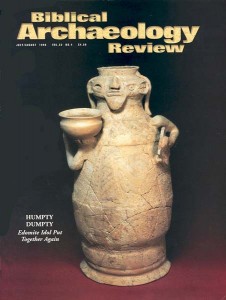‘En Hatzeva: Layer By Layer
Sidebar to: Smashing the Idols: Piecing Together an Edomite Shrine in Judah
Stratum 6—c. 10th century B.C.E.
Israelite fortresses were built in the Negev desert to protect the southern border from the Egyptians. In ‘En Hatzeva, a structure dating to this period—possibly to the time of King Solomon—resembles others from the 10th century B.C.E., such as one at Arad. In a 925 B.C.E. stela at Karnak, in Egypt, Pharaoh Sheshonq I (called Shishak in the Bible) boasts that he has conquered “the fortified cities of Judah.”
Stratum 5—9th–8th centuries B.C.E.
A large fortress, measuring 300 feet on each side, was built at ‘En Hatzeva. Associated with this and the Stratum 4 period are an Edomite shrine and a pit containing smashed cult objects. Who were the Edomites? In the Bible, the descendants of Esau form the kingdom of Edom—a rival of the Israelites, who are descended from Esau’s brother Jacob (also called Israel). Given the Bible’s description of ethnic connections between Israelites and Edomites, and that the Edomite language is closely related to Hebrew, the two groups may have come from the same stock. An Edomite kingdom existed by the 13th century B.C.E., stretching south of Nahal Zered and east of the Arava Valley. This kingdom was controlled by the Israelites during the united monarchy (tenth century B.C.E.), according to the Bible. Later, after a period of independence during the divided monarchy—with Israel in the north and Judah in the south—Edom submitted quietly to the Babylonians in about 604 B.C.E. With the Israelites in exile in Babylonia, Edomites moved into southern Judah, establishing their central city at Hebron; this is probably the Idumea of the post-exilic period (after 539 B.C.E.).
Already a library member? Log in here.
Institution user? Log in with your IP address.

